- Last Updated: December 16th, 2025
Key Takeaways
PCBs are environmentally persistent chemicals requiring careful and regulated cleanup efforts.
The EPA sets forth stringent protocols for managing and disposing of bulk PCB remediation waste.
The assessment and distribution of cleanup costs is a multifaceted process that involves various stakeholders.
Overview of PCB Cleanup Costs
On this page, we’ll discuss the responsibility for PCB Cleanup Costs, who bears the financial burden of PCB remediation, legal mechanisms for holding polluters accountable for PCB cleanup expenses, and much more.
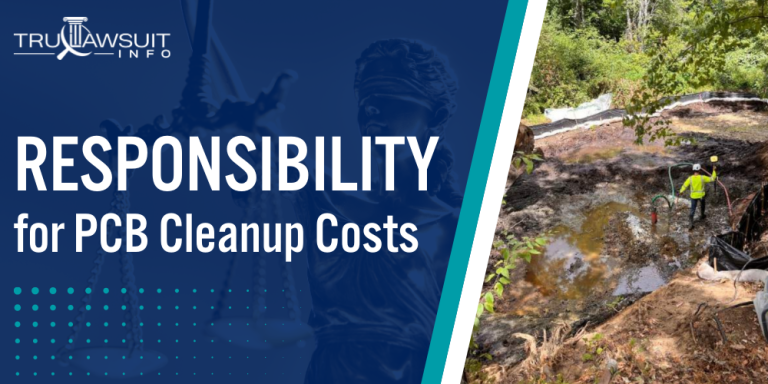
Intro to Responsibility for PCB Cleanup Costs
Here are some key points about responsibility for PCB cleanup costs:
- In many cases, the companies responsible for PCB contamination are held liable for cleanup costs under the “polluter pays” principle
- The Comprehensive Environmental Response, Compensation, and Liability Act (CERCLA) allows the EPA to hold parties responsible for contamination and require them to pay for PCB cleanup.
- Taxpayers may also bear some of the costs, particularly when the responsible parties are unable to pay or cannot be identified.
If you or a loved one has been exposed to PCBs and suffered health consequences, you may be eligible to file a PCB Lawsuit.
Contact TruLawsuit Info for a free consultation using the chat on this page to receive an instant case evaluation.
The Scope of PCB Contamination in the United States
Polychlorinated biphenyls (PCBs) have left a significant environmental footprint across the United States.

This section will examine the identification of contaminated sites and the financial implications of remediation efforts.
Identifying PCB-Contaminated Sites Nationwide
Identifying locations with PCB contamination is the first step in addressing this environmental challenge.
These are some of the steps involved:
- Sampling and Testing: Sites are evaluated by collecting and testing soil, sediment, and water samples to determine PCB concentrations.
- Public Records Review: Historical documentation of industrial operations helps identify potential PCB hotspots.
- On-Site Inspections: Experts conduct thorough inspections of suspected areas to assess the presence of PCBs.
- Reporting: Once identified, sites are documented and reported to appropriate environmental authorities, such as the EPA, for further action.
Responsiveness amongst environmental agencies and the public has increased awareness and identification of these sites.
Estimating the Total Cost of PCB Cleanup Efforts
The financial aspect of PCB remediation is a topic of much consideration.
To estimate the overall cost, the following factors are essential:
- Scope of Contamination: The extent and concentration of PCB contamination affect cleanup costs.
- Cleanup and Disposal Options: The chosen remediation strategy, whether landfilling, incineration, or chemical treatment, has varying costs.
- Location Accessibility: Remediation costs vary depending on the ease of access to the contaminated site.
- EPA Approval: The expenses associated with legal and administrative procedures for obtaining EPA approval for cleanup plans.
Established guidelines determine how PCBs should be cleaned up and disposed of, specifying techniques appropriate for different concentrations and forms of PCBs.
Detailed procedures for PCB remediation can be found in Title 40 of the Code of Federal Regulations (CFR), specifically in section 761.61.
Legal Framework for Assigning PCB Cleanup Responsibility
Assigning responsibility for PCB cleanup is governed by federal regulations and varying state and local statutes.
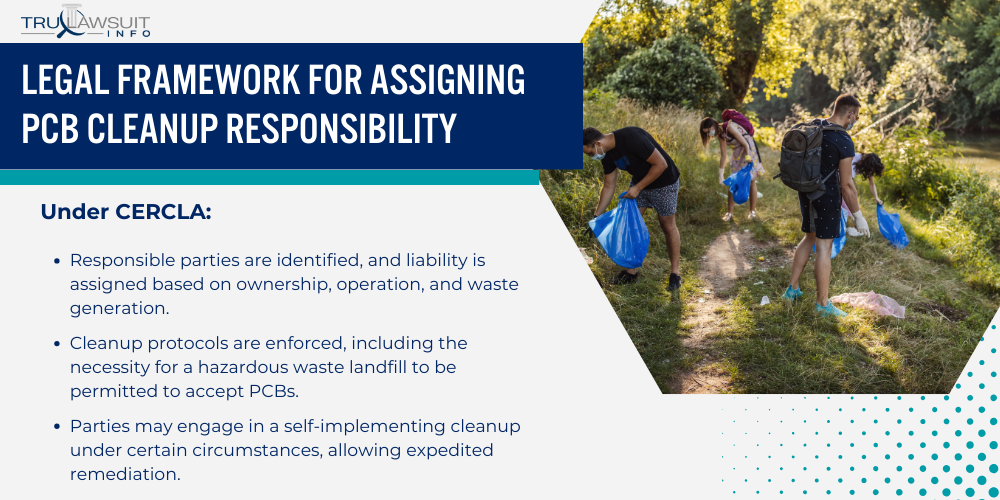
These laws define requirements for hazardous waste management, including cleanup completion notification, and detail the responsibilities of parties involved in PCB remediation.
The Comprehensive Environmental Response, Compensation, and Liability Act (CERCLA)
The Comprehensive Environmental Response, Compensation, and Liability Act (CERCLA), commonly known as Superfund, is the primary federal law that mandates the cleanup of sites contaminated with hazardous substances, including PCBs.
Under CERCLA:
- Responsible parties are identified, and liability is assigned based on ownership, operation, and waste generation.
- Cleanup protocols are enforced, including the necessity for a hazardous waste landfill to be permitted to accept PCBs.
- Parties may engage in a self-implementing cleanup under certain circumstances, allowing expedited remediation.
- Cleanup completion notifications are required, outlining the success and closure of PCB remediation activities.
They must also adhere to the regulations set forth by the Toxic Substances Control Act (TCSA), including specific PCB regulations.
State and Local Laws Governing PCB Remediation
In addition to federal laws, state and local regulations can play a significant role in PCB cleanup.
States often have their own versions of the TSCA or CERCLA that may:
- Determine the scope of the cleanup based on the severity of contamination.
- Ensure the proper disposal and handling of PCBs at a state level.
- Establish penalties for non-compliance with PCB cleanup requirements.
- Implement additional regulations for PCB remediation that complement or exceed federal standards.
Entities involved in PCB cleanup must be well-versed in the applicable federal, state, and local laws to plan and execute the remediation process effectively.
The Role of Potentially Responsible Parties (PRPs) in PCB Cleanup
To address PCB contamination, the involvement of Potentially Responsible Parties (PRPs) is integral in identifying accountability and sourcing funding for cleanup initiatives.
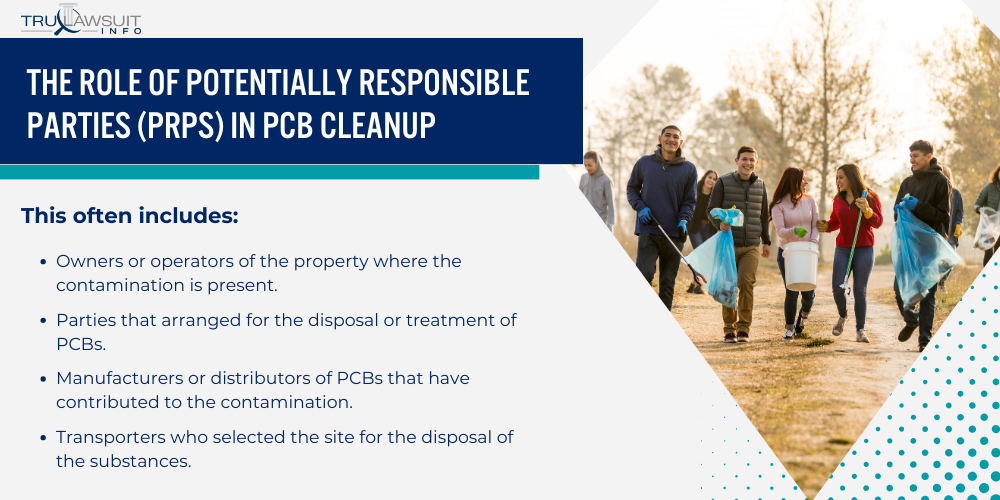
These parties play a crucial role in the remediation of PCB-contaminated sites and the meeting of disposal obligations.
Identifying and Notifying PRPs for PCB-Contaminated Sites
To initiate cleanup, one must first identify the PRPs associated with PCB contamination.
This often includes:
- Owners or operators of the property where the contamination is present.
- Parties that arranged for the disposal or treatment of PCBs.
- Manufacturers or distributors of PCBs that have contributed to the contamination.
- Transporters who selected the site for the disposal of the substances.
Notification is the subsequent essential step.
PRPs are formally advised of their legal responsibilities and potential liability related to the contaminated locales.
Negotiating PRP Contributions to Cleanup Costs
Upon notification, the negotiation begins.
Here are key factors that often come into play:
- Extent of Contamination: PRPs may be liable for costs proportional to the PCB concentration levels found at the site.
- Determination of Cost Shares: Equitable expense distribution among PRPs is negotiated, sometimes in a court of law.
- Long-term Disposal Programs: PRPs may be involved in planning and implementing sustainable disposal or decontamination efforts.
- Continual Site Management: Some agreements include ongoing responsibilities to monitor and maintain the site post-cleanup.
Negotiation also determines how cleanup costs are allocated among PRPs and how the cleanup plan aligns with environmental regulations and public health protections.
Government Funding for PCB Cleanup Projects
Government funding plays a pivotal role in the remediation of sites contaminated with polychlorinated biphenyls (PCBs).
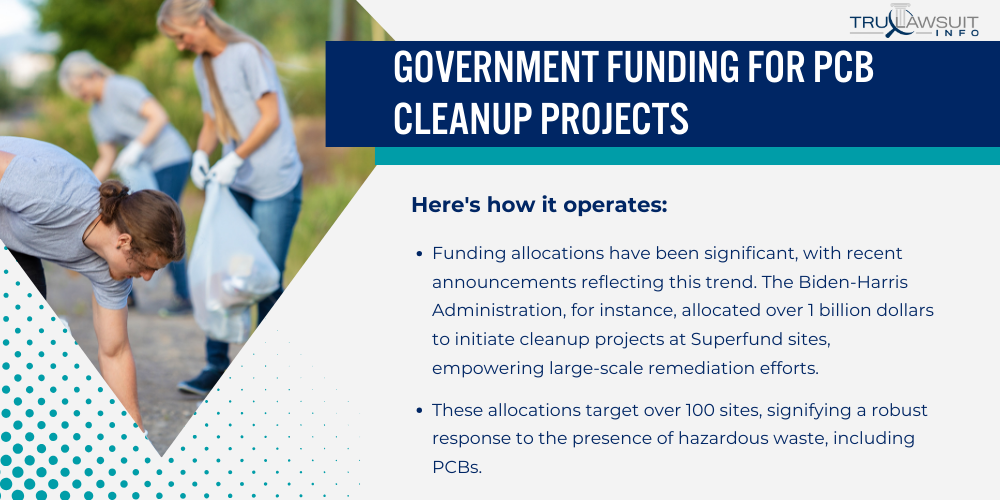
These efforts are crucial for protecting public health and preserving the environment.
The Superfund Program and PCB Remediation
The Superfund program, a federal initiative, is central to cleaning PCB-contaminated sites.
Here’s how it operates:
- Funding allocations have been significant, with recent announcements reflecting this trend. The Biden-Harris Administration, for instance, allocated over 1 billion dollars to initiate cleanup projects at Superfund sites, empowering large-scale remediation efforts.
- These allocations target over 100 sites, signifying a robust response to the presence of hazardous waste, including PCBs.
- Performance based cleanup option are part of the program’s approach, emphasizing effective and timely remediation strategies.
- Moreover, technological advancements have fostered methods for PCB degradation, aiming for a more sustainable impact on the affected ecosystems.
Other Federal and State Funding Sources for PCB Cleanup
In addition to the Superfund, an array of federal and state funding sources supports the cleanup and management of PCB-contaminated sites.
These resources are critical in addressing environmental health risks and facilitating the restoration of affected areas.
Various federal and state sources complement the Superfund, further fortifying the fight against PCB pollution:
- Resource conservation programs may offer financial assistance for projects decreasing PCB environmental impact.
- The regulated community—comprising businesses and industries—often contributes to cleanup funds through taxes or direct payment for site remediations they’re responsible for.
- Federal agencies, such as the EPA, provide guidelines and support for managing PCB remediation waste, reflecting the agency’s commitment to both environmental protection and public health safety, as described in their management of PCB remediation waste.
- State-specific funding initiatives can also bolster local cleanup strategies, ensuring a comprehensive approach to PCB issues.
The coordinated use of these funds exemplifies a profound commitment to mitigating the threat posed by PCBs to the environment and public health.
Case Studies of PCB Cleanup Cost Allocation
Effective PCB cleanup initiatives often involve significant cost allocations based on the scope of contamination and the restoration requirements.
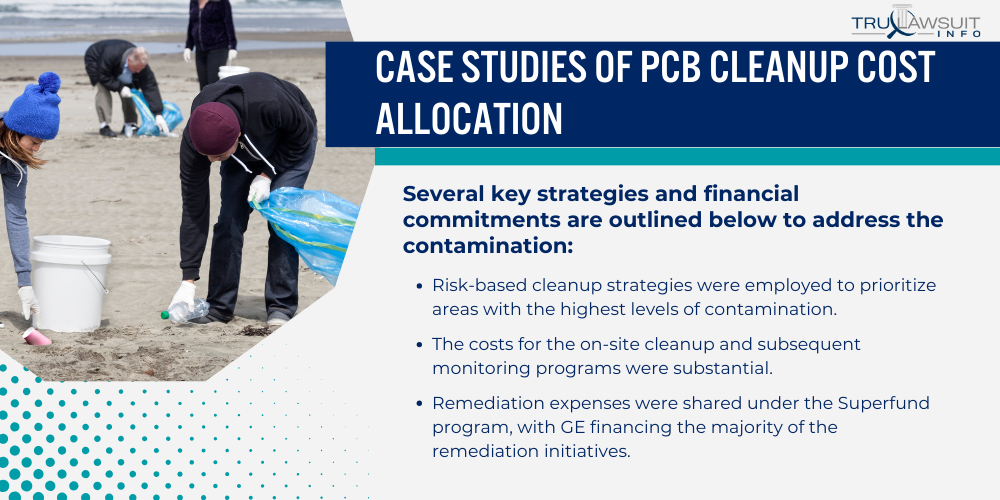
These case studies explore how different entities have tackled the financial aspects of PCB decontamination projects.
The Hudson River PCB Cleanup Project
The Hudson River cleanup is a well-documented case where cost allocation was meticulously scrutinized.
General Electric (GE) was held responsible for discharging PCBs into the river over several decades.
Several key strategies and financial commitments are outlined below to address the contamination:
- Risk-based cleanup strategies were employed to prioritize areas with the highest levels of contamination.
- The costs for the on-site cleanup and subsequent monitoring programs were substantial.
- Remediation expenses were shared under the Superfund program, with GE financing the majority of the remediation initiatives.
- A comprehensive remediation plan included dredging and capping of PCB contaminated sediments.
The New Bedford Harbor Superfund Site
New Bedford Harbor’s cleanup serves as another significant example of cost allocation among responsible parties for PCB contamination.
Highlighting the comprehensive measures taken for environmental restoration, the cleanup strategy encompassed several key components:
- A risk-based approach was utilized to assess the severity of PCB’s impact on the harbor’s ecosystem.
- The parties responsible for the pollution were identified and mandated to cover the remediation expenses.
- The strategy included on-site cleanup activities with a focus on hotspots to reduce the overall ecological risks.
- The project’s scale led to the creation of intricate financial agreements to ensure continued funding for the cleanup operations.
Challenges in Determining Responsibility for PCB Cleanup Costs
Addressing the financial responsibility for Polychlorinated Biphenyl (PCB) disposal presents distinct difficulties.
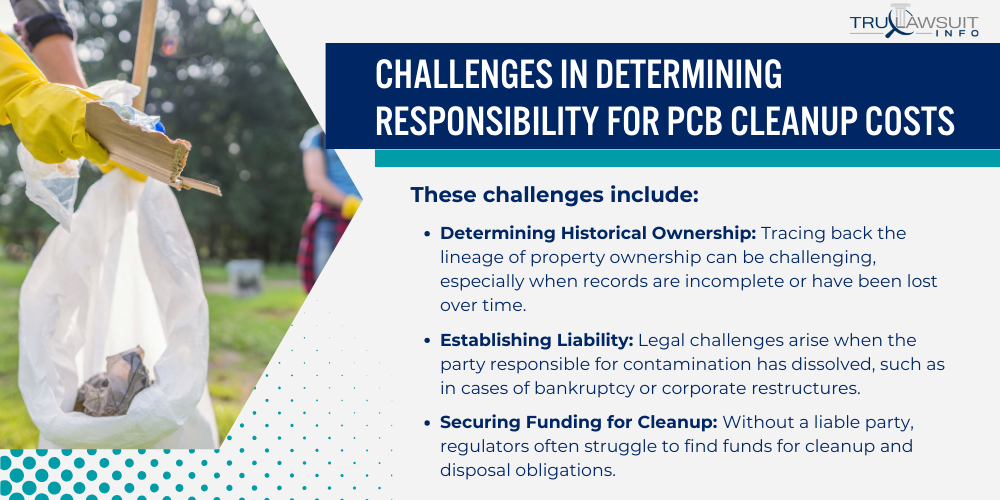
The process often involves identifying parties responsible for the contamination and determining how to allocate the associated costs effectively and fairly.
Orphan Sites and Unidentifiable Responsible Parties
Orphan sites, where the responsible entities either no longer exist or cannot be located, significantly complicate the process of cost recovery.
These challenges include:
- Determining Historical Ownership: Tracing back the lineage of property ownership can be challenging, especially when records are incomplete or have been lost over time.
- Establishing Liability: Legal challenges arise when the party responsible for contamination has dissolved, such as in cases of bankruptcy or corporate restructures.
- Securing Funding for Cleanup: Without a liable party, regulators often struggle to find funds for cleanup and disposal obligations.
- Risk to Public Health: These sites can pose an unreasonable risk to human health and the environment, increasing the urgency for cleanup actions.
Disputes Among Multiple PRPs at Complex Sites
When multiple potentially responsible parties (PRPs) are involved at a complex site, disputes are inevitable.
These can lead to:
- Extended Negotiations: PRPs often engage in lengthy discussions and legal battles to determine the extent of their financial responsibility.
- Allocation of Cleanup Costs: Arbitrating how much each PRP should contribute involves assessing the degree of contamination attributed to each party.
- Adherence to Cleanup Standards: Ensuring that extraction procedures and other remediation efforts meet regulatory standards can be contested among PRPs.
- Responsibility for Future Monitoring: Post-cleanup, there may be disagreements on who should bear the ongoing monitoring and potential further disposal costs.
Strategies for Minimizing PCB Cleanup Costs
Reducing the financial burden of PCB cleanup is possible through the adoption of innovative remediation technologies and fostering collaborative efforts.
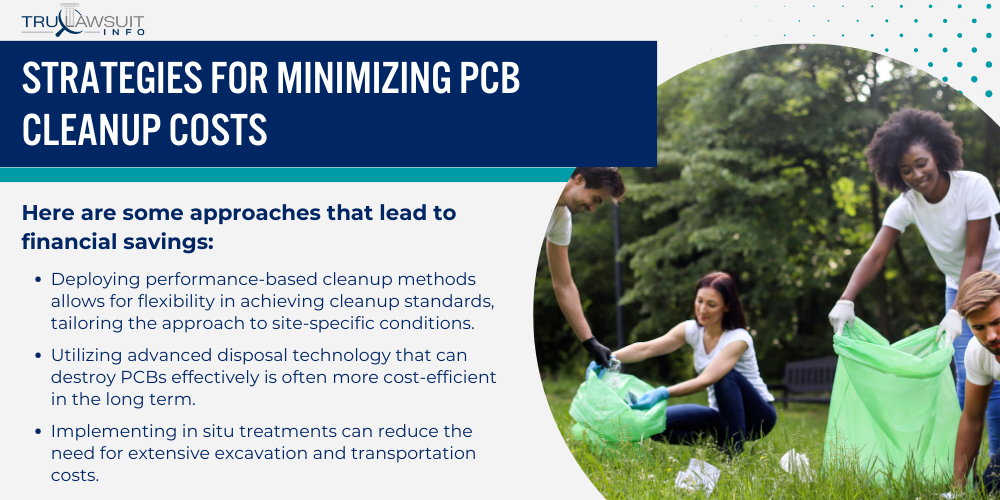
These strategies are aimed at enhancing efficiency and effectiveness in addressing contaminated sites.
Innovative Remediation Technologies and Approaches
Innovative remediation technologies can significantly lower PCB cleanup costs.
Here are some approaches that lead to financial savings:
- Deploying performance-based cleanup methods allows for flexibility in achieving cleanup standards, tailoring the approach to site-specific conditions.
- Utilizing advanced disposal technology that can destroy PCBs effectively is often more cost-efficient in the long term.
- Implementing in situ treatments can reduce the need for extensive excavation and transportation costs.
- Exploring bioremediation techniques that use natural organisms to break down contaminants in porous surfaces and soils.
Collaborative Efforts Among PRPs and Government Agencies
Collaborative efforts among Potentially Responsible Parties (PRPs) and government agencies have proven to be a key factor in efficiently managing environmental restoration projects.
By fostering an environment of cooperation rather than confrontation, these partnerships help expedite the cleanup of contaminated sites while ensuring adherence to environmental standards.
Collaborative efforts between Potentially Responsible Parties (PRPs) and government agencies can streamline cleanup processes and reduce expenses:
- PRPs can share the costs and resources required for extensive cleanup projects, distributing the financial load more evenly.
- Joint participation in the planning process can lead to the identification of more cost-effective strategies tailored to the site.
- By working directly with regulatory bodies, PRPs can take advantage of flexible provisions allowed within regulations to minimize costs.
- Collaborative lead efforts in research and development may uncover new, less expensive technologies for PCB cleanup and disposal.
The Long-Term Economic Impact of PCB Contamination
Polychlorinated biphenyls (PCBs) have left a lasting mark on both the environment and the economy.
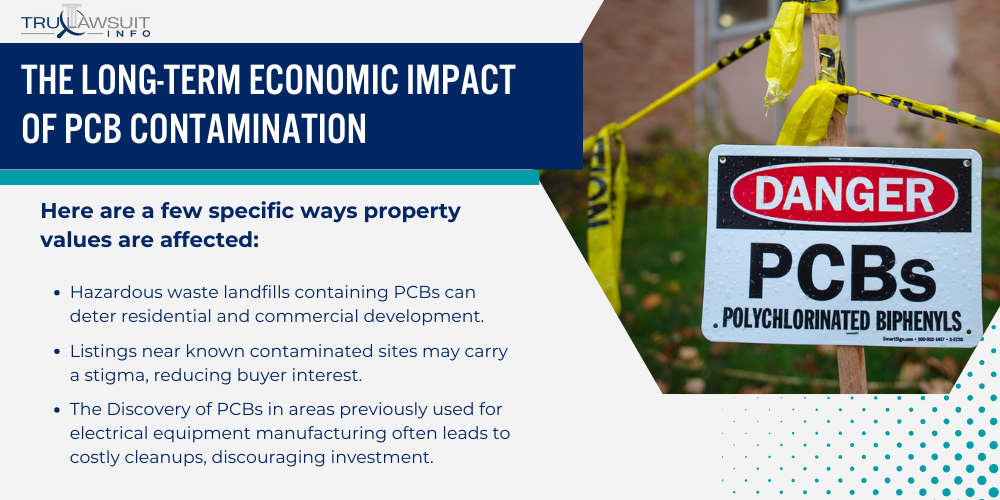
They impact property values and incur liability for corporations, affecting stakeholders across various sectors.
Decreased Property Values in Affected Communities
The presence of PCB remediation waste can significantly lower the property values within communities.
Here are a few specific ways property values are affected:
- Hazardous waste landfills containing PCBs can deter residential and commercial development.
- Listings near known contaminated sites may carry a stigma, reducing buyer interest.
- The Discovery of PCBs in areas previously used for electrical equipment manufacturing often leads to costly cleanups, discouraging investment.
- Homes and businesses may face increased insurance premiums due to perceived environmental risks.
Potential Liability for Corporations Involved in PCB Production and Use
Corporations tied to the production and use of PCBs face substantial financial liabilities.
The economic repercussions for these entities include:
- Cleanup Costs: Firms are responsible for funding environmental cleanup, which can extend into millions of dollars.
- Legal Liabilities: Companies may face lawsuits for damages stemming from PCB pollution.
- Regulatory Fines: Noncompliance with federal regulations for managing PCB cleanup can result in hefty penalties.
- Reputational Damage: An association with PCB contamination can affect a company’s market value and stakeholder trust.
Ensuring Equitable Distribution of PCB Cleanup Costs
The equitable distribution of costs associated with PCB cleanup is essential to ensure that financial responsibility is appropriately allocated and to prevent taxpayers from shouldering an unfair share of the burden.
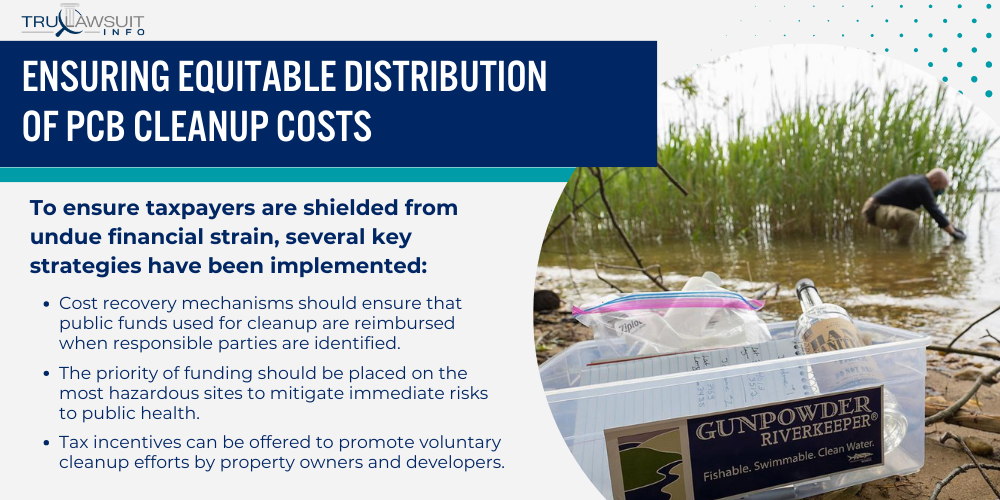
Protecting Taxpayers from Unfair Burden
Taxpayers often worry about paying for environmental cleanups.
Therefore, it is vital to have mechanisms in place that protect them.
Federal toxic substances legislation can offer relief by laying out clear guidelines on who pays for what.
To ensure taxpayers are shielded from undue financial strain, several key strategies have been implemented:
- Cost recovery mechanisms should ensure that public funds used for cleanup are reimbursed when responsible parties are identified.
- The priority of funding should be placed on the most hazardous sites to mitigate immediate risks to public health.
- Tax incentives can be offered to promote voluntary cleanup efforts by property owners and developers.
- Public-private partnerships can be considered to spread the financial load more evenly.
Disposal approval processes must be transparent and closely monitored to ensure that all parties adhere to cleanup standards, avoiding unforeseen expenditures falling on the community.
Holding Responsible Parties Accountable for Contamination
Those responsible for PCB contamination must bear the cost of cleanup activities.
Accountability is not just a matter of fairness but also a deterrent for future negligence.
To solidify this principle, several measures have been instituted:
- Implementing strict liability laws places the financial burden of cleanup activities on those at fault.
- Mandatory insurance for industries handling hazardous substances can offset the costs of potential contaminations.
- Cleanup standards need enforcement through regular inspections and penalties for non-compliance.
- Superfund legislation and similar programs should be applied to recover costs from past contaminators.
By ensuring these entities are held financially responsible, the integrity of environmental cleanup efforts is upheld, and the burden on taxpayers is minimized.
Trulawsuit Info: #1 PCB Cleanup Lawyer
When dealing with the legalities of PCB cleanup, it’s essential to find a lawyer with specialized knowledge in the field.
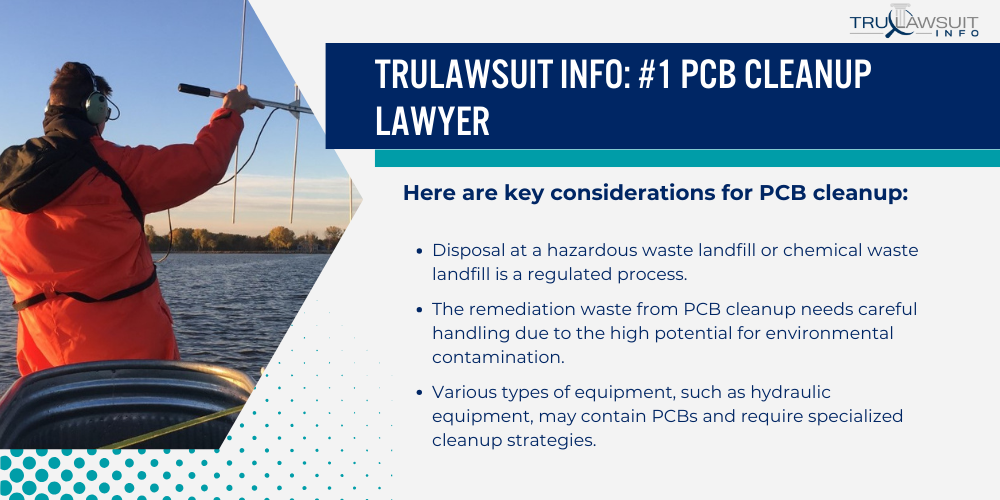
PCBs, or polychlorinated biphenyls, were once widely used for their electrical insulating properties in a variety of industrial applications.
However, due to their environmental and health risks, managing and disposing of PCB wastes is strictly regulated.
The right lawyer can guide individuals and companies through the disposal options for PCBs.
These options are often detailed in the Federal Register, where amendments to PCB cleanup and disposal regulations are documented.
Here are key considerations for PCB cleanup:
- Disposal at a hazardous waste landfill or chemical waste landfill is a regulated process.
- The remediation waste from PCB cleanup needs careful handling due to the high potential for environmental contamination.
- Various types of equipment, such as hydraulic equipment, may contain PCBs and require specialized cleanup strategies.
- Disposal can occur either on-site or at an off-site disposal facility, depending on the concentration of PCBs and regulations.
Frequently Asked Questions
-
The Environmental Protection Agency (EPA) advises a systematic approach to PCB cleanup, which includes identification, containment, and remediation of PCB-contaminated areas following specific federal regulations outlined in Title 40 of the Code of Federal Regulations (CFR) Part 761.
-
Recent updates to PCB cleanup standards are typically found in the EPA’s revised policies and guidance materials.
These may include modifications to cleanup methodologies, safety protocols, and disposal requirements to align with ongoing research and environmental safety goals.
-
Effective PCB removal from the environment involves strategies like thermal treatment, chemical dechlorination, and excavation of contaminated soil, with the chosen method depending on the PCB concentration and the area affected.
-
Best practices for PCB spill response and clean-up entail immediate spill containment, the use of personal protective equipment (PPE), detailed verification sampling and testing for PCB concentrations, and an EPA-approved disposal or decontamination process.
-
PCB remediation waste should be handled with care and disposed of according to the EPA’s stringent regulations.
These regulations dictate disposal methods based on the concentration and nature of the PCB waste, such as incineration or landfilling in EPA-approved facilities.
-
To identify and manage PCBs in waste materials, testing for PCB concentrations is necessary.
This is followed by the categorization of the waste according to federal guidelines, ensuring proper storage, transportation, and disposal in compliance with EPA regulations.

Attorney Jessie Paluch, founder of TruLawsuit Info, has over 25 years of experience as a personal injury and mass tort attorney, and previously worked as an international tax attorney at Deloitte. Jessie collaborates with attorneys nationwide — enabling her to share reliable, up-to-date legal information with our readers.
Legally Reviewed
This article has been written and reviewed for legal accuracy and clarity by the team of writers and legal experts at TruLawsuit Info and is as accurate as possible. This content should not be taken as legal advice from an attorney. If you would like to learn more about our owner and experienced injury lawyer, Jessie Paluch, you can do so here.
Fact-Checked
TruLawsuit Info does everything possible to make sure the information in this article is up to date and accurate. If you need specific legal advice about your case, contact our team by using the chat on the bottom of this page. This article should not be taken as advice from an attorney.
You can learn more about the PCB Exposure Lawsuit by visiting any of our pages listed below:
Here, at Tru Lawsuit Info, we’re committed to helping victims get the justice they deserve.
To do this, we actively work to connect them with attorneys who are experts in litigating cases similar to theirs.
Table of Contents
Tru Lawsuit Info is a reliable source of information about issues that may affect your health and safety, such as faulty products, data breaches, and environmental hazards.
Our team of experienced writers collaborates with medical professionals, lawyers, and advocates to produce informative articles, guides, and other resources that raise awareness of these topics.
Our thorough research provides consumers with access to reliable information and updates on lawsuits happening around the country. We also can connect consumers with attorneys if they need assistance.
Here, at Tru Lawsuit Info, we’re committed to helping victims get the justice they deserve.
To do this, we actively work to connect them with attorneys who are experts in litigating cases similar to theirs.
